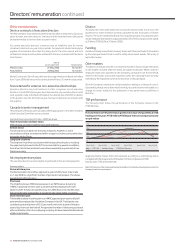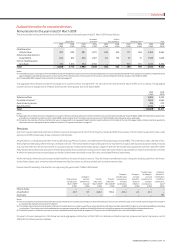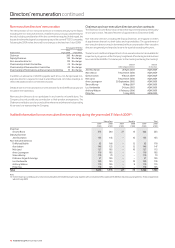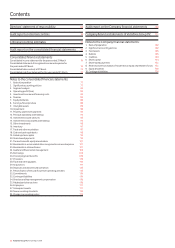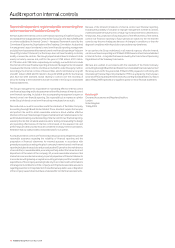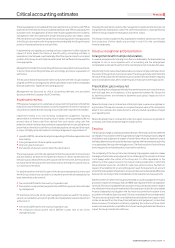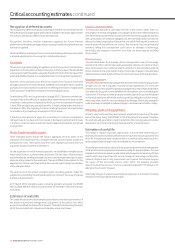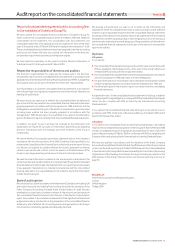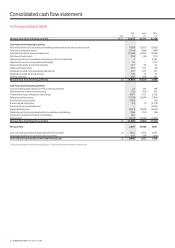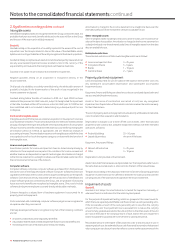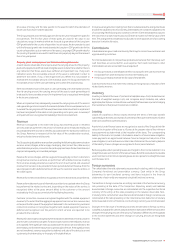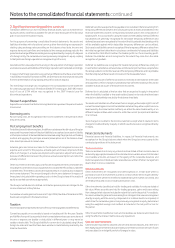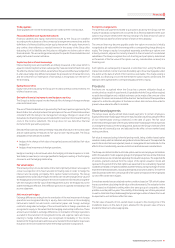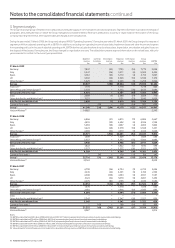Vodafone 2009 Annual Report Download - page 74
Download and view the complete annual report
Please find page 74 of the 2009 Vodafone annual report below. You can navigate through the pages in the report by either clicking on the pages listed below, or by using the keyword search tool below to find specific information within the annual report.
72 Vodafone Group Plc Annual Report 2009
Critical accounting estimates continued
Licences and spectrum fees
The estimated useful life is, generally, the term of the licence, unless there is a
presumption of renewal at negligible cost. Using the licence term reflects the period
over which the Group will receive economic benefit. For technology specific licences
with a presumption of renewal at negligible cost, the estimated useful economic life
reflects the Group’s expectation of the period over which the Group will continue to
receive economic benefit from the licence. The economic lives are periodically
reviewed, taking into consideration such factors as changes in technology.
Historically, any changes to economic lives have not been material following
these reviews.
Customer bases
The estimated useful life principally reflects management’s view of the average
economic life of the customer base and is assessed by reference to customer churn
rates. An increase in churn rates may lead to a reduction in the estimated useful life
and an increase in the amortisation charge. Historically, changes to the estimated
useful lives have not had a significant impact on the Group’s results and financial position.
Capitalised software
The useful life is determined by management at the time the soft ware is acquired and
brought into use and is regularly reviewed for appropriateness. For computer
software licences, the useful life represents management’s view of expected benefits
over which the Group will receive benefits from the software, but not exceeding the
licence term. For unique software products controlled by the Group, the life is based
on historical experience with similar products as well as anticipation of future events,
which may impact their life, such as changes in technology. Historically, changes in
useful lives have not resulted in material changes to the Group’s amortisation charge.
Property, plant and equipment
Property, plant and equipment also represent a significant proportion of the asset
base of the Group, being 12.6% (2008: 13.1%) of the Group’s total assets. Therefore,
the estimates and assumptions made to determine their carrying value and related
depreciation are critical to the Group’s financial position and performance.
Estimation of useful life
The charge in respect of periodic depreciation is derived after determining an
estimate of an asset’s expected useful life and the expected residual value at the end
of its life. Increasing an asset’s expected life or its residual value would result in a
reduced depreciation charge in the consolidated income statement.
The useful lives and residual values of Group assets are determined by management
at the time the asset is acquired and reviewed annually for appropriateness. The lives
are based on historical experience with similar assets as well as anticipation of future
events, which may impact their life, such as changes in technology. Furthermore,
network infrastructure is only depreciated over a period that extends beyond
the expiry of the associated licence under which the operator provides
telecommunications services,
if there is a reasonable expectation of renewal or an
alternative future use for the asset.
Historically, changes in useful lives and residual values have not resulted in material
changes to the Group’s depreciation charge.
Recognition of deferred tax assets
The recognition of deferred tax assets is based upon whether it is more likely than not
that sufficient and suitable taxable profits will be available in the future, against which
the reversal of temporary differences can be deducted.
Recognition, therefore, involves judgement regarding the future financial
performance of the particular legal entity or tax group in which the deferred tax asset
has been recognised.
Historical differences between forecast and actual taxable profits have not resulted
in material adjustments to the recognition of deferred tax assets.
Goodwill
The amount of goodwill initially recognised as a result of a business combination is
dependent on the allocation of the purchase price to the fair value of the identifiable
assets acquired and the liabilities assumed. The determination of the fair value of the
assets and liabilities is based, to a considerable extent, on management’s judgement.
Allocation of the purchase price affects the results of the Group as finite lived
intangible assets are amortised, whereas indefinite lived intangible assets, including
goodwill, are not amortised and could result in differing amortisation charges based
on the allocation to indefinite lived and finite lived intangible assets.
On transition to IFRS, the Group elected not to apply IFRS 3, “Business combinations”,
retrospectively as the difficulty in applying these requirements to the large number
of business combinations completed by the Group from incorporation through to
1 April 2004 exceeded any potential benefits. Goodwill arising before the date of
transition to IFRS, after adjusting for items including the impact of proportionate
consolidation of joint ventures, amounted to £78,753 million.
If the Group had elected to apply the accounting for business combinations
retrospectively, it may have led to an increase or decrease in goodwill and increase
in licences, customer bases, brands and related deferred tax liabilities recognised
on acquisition.
Finite lived intangible assets
Other intangible assets include the Group’s aggregate amounts spent on the
acquisition of 2G and 3G licences, computer software, customer bases, brands and
development costs. These assets arise from both separate purchases and from
acquisition as part of business combinations.
On the acquisition of mobile network operators, the identifiable intangible assets
may include licences, customer bases and brands. The fair value of these assets is
determined by discounting estimated future net cash flows generated by the asset,
where no active market for the assets exist. The use of different assumptions for the
expectations of future cash flows and the discount rate would change the valuation
of the intangible assets.
The relative size of the Group’s intangible assets, excluding goodwill, makes the
judgements surrounding the estimated useful lives critical to the Group’s financial
position and performance.
At 31 March 2009, intangible assets, excluding goodwill, amounted to £20,980
million (2008: £18,995 million) and represented 13.7% (2008: 14.9%) of the Group’s
total assets.
Estimation of useful life
The useful life used to amortise intangible assets relates to the future performance of
the assets acquired and management’s judgement of the period over which
economic benefit will be derived from the asset. The basis for determining the useful
life for the most significant categories of intangible assets is as follows:


